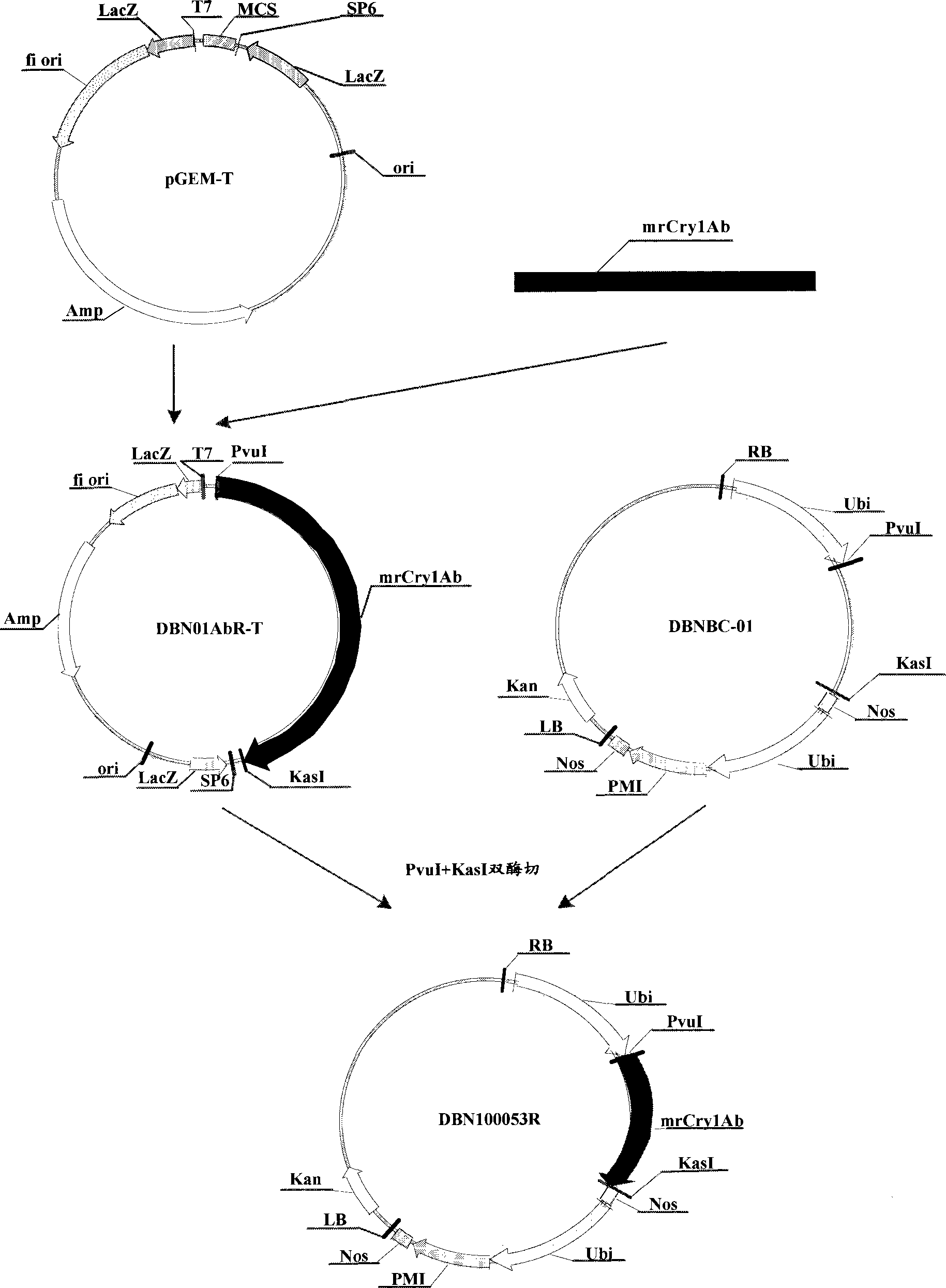Insecticide gene and application thereof
A technology for killing insects and pests, which can be used in the fields of insecticides, genetic engineering, plant genetic improvement, etc., and can solve the problems of unsatisfactory expression and virulence
- Summary
- Abstract
- Description
- Claims
- Application Information
AI Technical Summary
Problems solved by technology
Method used
Image
Examples
no. 1 example
[0046] First embodiment, selection, optimization and synthesis of natural Cry1Ab gene sequence
[0047] 1. Select the natural Cry1Ab gene sequence for optimization
[0048] The nucleotide sequence of the natural Cry1Ab8 gene with the serial number AAA22551 registered by Oeda et al. in 1993 was selected as the basis for the optimization and modification of the insecticidal gene of the present invention. The nucleotide sequence of the natural Cry1Ab8 gene is as SEQ ID NO: 2 in the sequence table. As shown, the amino acid sequence of the native Cry1Ab8 gene is shown in SEQ ID NO: 3 in the sequence listing.
[0049] 2. Intercept the natural Cry1Ab gene sequence for optimization and transformation
[0050] The nucleotide sequence corresponding to positions 1 to 615 of the amino acid sequence encoded by the nucleotide sequence of the above-mentioned natural Cry1Ab8 gene was cut out.
[0051] 3. Optimize the above-mentioned truncated natural Cry1Ab gene sequence
[0052] Keeping t...
no. 2 example
[0057] Second embodiment, construction of recombinant expression vector and transformation of recombinant expression vector into Agrobacterium
[0058] 1. Construction of the recombinant cloning vector DBN01Ab-T containing the optimized Cry1Ab gene sequence
[0059] The synthesized optimized Cry1Ab gene sequence was connected to the cloning vector pGEM-T (Promega, Madison, USA, CAT: A3600), and the operation steps were carried out according to the instructions of the pGEM-T vector product of Promega Company to obtain the recombinant cloning vector DBN01Ab-T. Its construction Process such as figure 1(wherein, Amp represents ampicillin resistance gene; f1 represents the origin of replication of phage f1; LacZ is the LacZ initiation codon; SP6 is the SP6 RNA polymerase promoter; T7 is the T7 RNA polymerase promoter; mCry1Ab is the optimized Cry1Ab gene sequence (SEQ ID NO: 1); MCS is the multiple cloning site).
[0060] Then the recombinant cloning vector DBN01Ab-T was transfor...
no. 3 example
[0070] The third embodiment, the acquisition and verification of the maize plant transformed into the optimized Cry1Ab gene sequence
[0071] 1. Obtain the maize plant transformed into the optimized Cry1Ab gene sequence
[0072] According to the conventional Agrobacterium infection method, the aseptically cultured immature embryos of maize variety Zong 31 (Z31) were co-cultivated with the Agrobacterium described in 4 in the second example, so that the 2 and 3 in the second example were co-cultured. The constructed recombinant expression vectors DBN100053 and DBN100053R (known sequences) T-DNA (including the promoter sequence of the maize Ubiquitin gene, the optimized Cry1Ab gene sequence, the known optimized Cry1Ab gene sequence, the PMI gene and the Nos terminator sequence) were transfected. Into the maize genome, a maize plant transformed with the optimized Cry1Ab gene sequence and a maize plant with a known optimized Cry1Ab gene sequence (positive control) were obtained; at...
PUM
 Login to View More
Login to View More Abstract
Description
Claims
Application Information
 Login to View More
Login to View More - R&D
- Intellectual Property
- Life Sciences
- Materials
- Tech Scout
- Unparalleled Data Quality
- Higher Quality Content
- 60% Fewer Hallucinations
Browse by: Latest US Patents, China's latest patents, Technical Efficacy Thesaurus, Application Domain, Technology Topic, Popular Technical Reports.
© 2025 PatSnap. All rights reserved.Legal|Privacy policy|Modern Slavery Act Transparency Statement|Sitemap|About US| Contact US: help@patsnap.com



